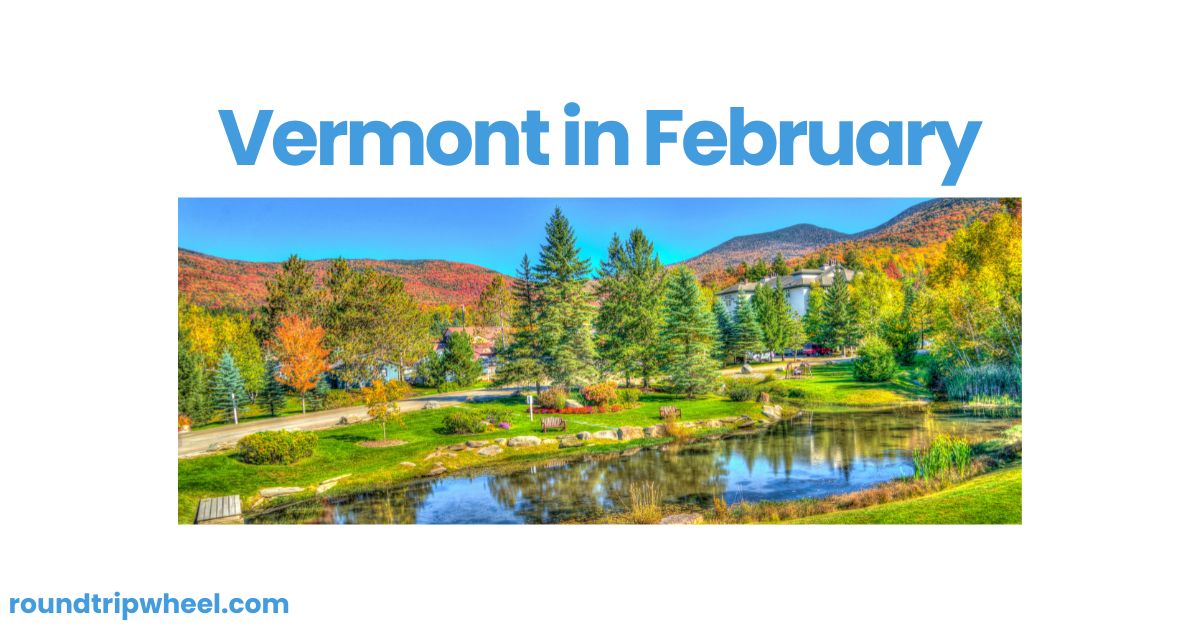Vermont in February: A Winter Wonderland Adventure

As the calendar turns to February, Vermont transforms into a magical winter playground, offering visitors a quintessential New England experience. From snow-capped mountains to cozy villages, the Green Mountain State beckons winter enthusiasts and those seeking a serene escape alike. Whether you’re planning to hit the slopes, explore charming towns, or simply relax by a crackling fireplace, Vermont in February promises an unforgettable adventure.
Weather and Preparation
February in Vermont is the heart of winter, with temperatures typically ranging from the low teens to mid-30s Fahrenheit. While the cold can be bracing, it’s also what makes Vermont’s winter activities possible and creates those picture-perfect snowy landscapes.
Packing appropriately is crucial for enjoying your Vermont winter getaway. Layering is key – start with a moisture-wicking base layer, add insulating mid-layers, and top it off with a waterproof and windproof outer layer. Don’t forget warm socks, insulated boots, gloves or mittens, a hat, and a scarf. If you’re planning outdoor activities, consider bringing hand and foot warmers for extra comfort.
Skiing and Snowboarding
Vermont is renowned for its skiing and snowboarding, with over 20 ski areas scattered throughout the state. February often brings the best conditions of the season, with a deep snowpack and frequent fresh powder.
Stowe Mountain Resort is often considered the crown jewel of Vermont skiing. With 116 trails spread across 485 acres and a vertical drop of 2,360 feet, it offers terrain for all skill levels. The charming town of Stowe at the base of the mountain adds to the overall experience with its quaint shops and restaurants.
Killington Resort, known as “The Beast of the East,” boasts the largest skiable area in the Eastern United States. With six peaks, 212 trails, and 28 lifts, Killington offers diverse terrain and typically has one of the longest seasons in the East.
For families, Smugglers’ Notch Resort is hard to beat. It consistently ranks as one of the top family ski resorts in North America, offering excellent children’s programs and a variety of non-skiing activities.
Other notable ski areas include Okemo Mountain Resort, known for its impeccable grooming, and Jay Peak Resort, which receives the most natural snow of any Eastern resort due to its unique microclimate.
If you’re new to skiing or snowboarding, February is an excellent time to learn. Most resorts offer lessons for all ages and skill levels. Many also celebrate National Learn to Ski and Snowboard Month in January, with promotions often extending into February.
Cross-Country Skiing and Snowshoeing
For those who prefer a quieter winter experience, Vermont offers extensive cross-country skiing and snowshoeing opportunities. The Trapp Family Lodge in Stowe (yes, that Trapp family of “The Sound of Music” fame) boasts over 60 miles of groomed and backcountry trails. The lodge’s Austrian-inspired architecture and rich history add a unique charm to the experience.
The Craftsbury Outdoor Center in Vermont’s Northeast Kingdom is another premier destination for Nordic skiing, with over 100 kilometers of trails winding through beautiful forests and open fields.
Many of Vermont’s state parks, such as Groton State Forest and Little River State Park, offer trails for both cross-country skiing and snowshoeing. These activities provide a peaceful way to explore Vermont’s winter landscapes and are excellent for wildlife viewing.
Winter Activities Beyond Skiing
Vermont’s winter offerings extend far beyond skiing and snowboarding. Ice skating is a popular pastime, with many towns maintaining outdoor rinks. The Lake Morey Resort in Fairlee boasts a 4.5-mile skating trail around Lake Morey, the longest in the United States.
For a unique winter experience, consider dog sledding. Several outfitters, such as Eden Dogsledding in Eden Mills, offer rides and hands-on mushing experiences.
Snowmobiling is another exciting way to explore Vermont’s winter terrain. The Vermont Association of Snow Travelers (VAST) maintains over 5,000 miles of groomed trails throughout the state.
For a more relaxed activity, take a horse-drawn sleigh ride. Many farms and resorts, including the Mountain Top Inn & Resort in Chittenden, offer scenic rides through snowy fields and forests.
Ice fishing is a beloved Vermont tradition. Lake Champlain, with its variety of fish species, is a popular destination. Remember to check ice conditions and obtain the necessary licenses before venturing out.
Vermont Towns and Villages
February is an ideal time to explore Vermont’s charming towns and villages. Burlington, the state’s largest city, offers a vibrant atmosphere even in the depths of winter. Stroll down Church Street Marketplace, a pedestrian-only shopping and dining district, or visit the ECHO Leahy Center for Lake Champlain to learn about the region’s natural history.
Woodstock, often called “the prettiest small town in America,” is particularly enchanting in winter. Its covered bridges and historic buildings look like something out of a Norman Rockwell painting when dusted with snow.
Stowe village, separate from the ski resort, is worth exploring for its quaint shops, excellent restaurants, and the Vermont Ski and Snowboard Museum.
Manchester, in southern Vermont, offers a mix of history, culture, and outdoor recreation. Visit Hildene, the Lincoln family home, or browse the outlets and local boutiques.
Food and Drink
Vermont’s culinary scene shines in winter, with hearty meals perfect for refueling after a day in the snow. Sample Vermont classics like cheddar cheese soup, pot roast, and maple-glazed root vegetables.
No trip to Vermont is complete without indulging in maple syrup. February and March are sugaring season, when maple sap starts flowing. Many sugarhouses offer tours and tastings. The New England Maple Museum in Pittsford provides a comprehensive look at the history and process of maple syrup production.
Vermont is also known for its craft beer scene. The Alchemist in Stowe, famous for its Heady Topper IPA, and Hill Farmstead Brewery in Greensboro are world-renowned. Many breweries offer tours and tastings, providing a perfect après-ski activity.
For a sweet treat, don’t miss Ben & Jerry’s Factory in Waterbury. While production viewing is limited in winter, the gift shop and Flavor Graveyard are open year-round.
Accommodations
Vermont offers a wide range of accommodations to suit every taste and budget. For a luxury experience, consider the Woodstock Inn & Resort, which combines elegant accommodations with easy access to outdoor activities.
The Trapp Family Lodge in Stowe offers a unique Austrian-inspired experience, with cross-country skiing right outside your door.
For a more intimate stay, Vermont’s many bed and breakfasts provide cozy accommodations and personal service. The Inn at Weathersfield in Perkinsville is known for its exceptional farm-to-table dining.
If you’re looking for ski-in/ski-out convenience, consider on-mountain lodging at resorts like Stratton or Okemo.
Events and Festivals
February in Vermont is filled with winter celebrations. The Stowe Winter Carnival, typically held in late January and early February, features ice carving competitions, ski races, and a village block party.
The Vermont Maple Sugar Makers’ Association hosts various events throughout February and March, including open house weekends where you can visit sugarhouses across the state.
For arts and culture enthusiasts, the Brattleboro Winter Carnival offers ten days of activities, including a parade, ice skating shows, and sugar-on-snow parties.
Winter Driving and Safety
While Vermont’s beauty is undeniable in winter, it’s important to be prepared for winter driving conditions. If you’re renting a car, consider one with all-wheel or four-wheel drive. Snow tires are recommended, especially if you plan to venture into mountainous areas.
Always check weather forecasts and road conditions before setting out. The Vermont Agency of Transportation provides real-time road condition updates on their website and through their mobile app.
Carry an emergency kit in your car, including a shovel, ice scraper, jumper cables, flashlight, blankets, and extra warm clothing. It’s also wise to keep your gas tank at least half full to prevent fuel line freeze-up.
Conclusion
A February visit to Vermont offers a quintessential winter experience. From world-class skiing and snowboarding to cozy evenings by the fire, the Green Mountain State provides a perfect backdrop for winter adventures. Whether you’re seeking outdoor thrills or quiet relaxation, Vermont’s natural beauty, charming towns, and warm hospitality create memories that will last long after the snow has melted.
As you plan your trip, remember that Vermont’s winter weather can be unpredictable. Flexibility and proper preparation are key to enjoying all that the state has to offer. Embrace the cold, savor the local flavors, and immerse yourself in the unique culture and landscapes that make Vermont a true winter wonderland. Your February escape to Vermont promises to be an unforgettable journey into the heart of New England winter.

About Author
Hey there, fellow explorers! I’m Mark Rodriguez, a big fan of adventures and always hungry for more. Packed with stories and a trusty camera, I’m on a mission to explore cool places around the world.
I love diving into new cultures and landscapes. As a travel writer, my goal is to get you excited about stepping out of your comfort zone, trying new things, and discovering the awesome magic our world has.
Check out my blog for cool stories, travel ideas, and helpful tips to plan your own amazing getaway!




